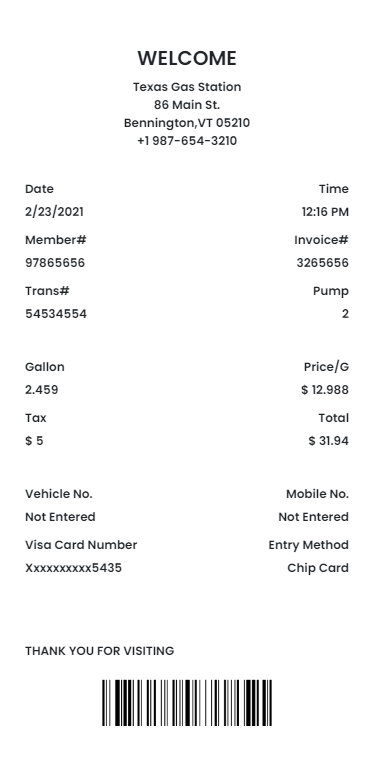Use a Fake Receipts Generator and Gas Receipt Maker Responsibly in the Digital Age
In today’s digital landscape, the demand for receipt generation tools is increasing across industries. Whether it’s for personal budgeting, business expense tracking, or demonstration purposes, tools like a fake receipts generator or gas receipt maker have become more visible online. While these tools serve a range of legitimate and legal purposes, they also carry ethical and legal implications if misused.
Understanding how a fake receipts generator and gas receipt maker works, their appropriate uses, and the risks involved is essential for professionals, students, and business owners alike. This article dives deep into their practical applications, best practices, and the fine line between useful and unethical.

What Is a Fake Receipts Generator?
A fake receipts generator is a digital tool or software that creates realistic-looking receipts for various types of transactions. These tools allow users to input custom details such as merchant name, date, item list, amount, and taxes to generate a receipt that looks genuine. The most popular categories include retail, restaurants, hotels, and transportation.
People often use these generators for:
Lost receipt reconstruction: When a legitimate receipt is lost and a record is needed for expense reporting or returns.
Education and training: Teachers and business trainers may use them to create realistic practice materials.
Budget tracking and demos: Freelancers and startups often use mock receipts to test accounting software or demonstrate client billing formats.
However, using a fake receipts generator for fraudulent reimbursements, tax manipulation, or scamming insurance claims is illegal and unethical.
What Is a Gas Receipt Maker?
A gas receipt maker is a more niche version of a receipts generator that specializes in creating fuel-related receipts. These are especially popular with individuals who travel for work, such as delivery drivers, truckers, or sales reps who need to log fuel expenses.
Gas receipt makers let users customize details such as:
Gas station name and location
Fuel type and quantity
Price per gallon or litre
Date and time of purchase
Total cost
Professionals who are required to maintain accurate fuel logs may use gas receipt makers to reconstruct missing receipts, ensuring they are reimbursed accurately for out-of-pocket expenses. Businesses may also use these tools for mockups or creating sample reports for internal training.
Legal vs. Illegal Use: Know the Difference
While the names “fake receipts generator” and “gas receipt maker” can raise eyebrows, it’s important to understand that the tools themselves are not illegal—how they are used is what matters.
Legal and ethical uses include:
Reconstructing lost receipts when the purchase was genuine.
Creating placeholders for accounting or software demonstrations.
Educational simulations for finance or business students.
Illegal and unethical uses include:
Submitting fake receipts for financial gain.
Falsifying business or tax records.
Committing fraud against employers, insurance, or government agencies.
Using a fake gas receipt, for example, to claim reimbursements for fuel never purchased is considered fraud and can result in legal penalties, including termination, fines, or even criminal charges.
Why Transparency and Honesty Matter
Many companies have strict policies regarding expense submissions and financial documentation. Using a fake receipts generator or gas receipt maker without proper disclosure, even for seemingly harmless reasons, can damage your credibility and trust.
Freelancers and small business owners must be especially careful. Maintaining integrity in your financial records not only keeps you legally safe but also helps build a reputation for professionalism and transparency—two key factors in winning clients and long-term contracts.
If you’re ever in a situation where a receipt is lost, and you need a reconstructed version, it’s best to:
Disclose that it is a recreated document.
Provide backup evidence such as credit card transactions, mileage logs, or email confirmations.
Label it as “Replacement” or “Recreated for record purposes.”
This approach shows you’re being honest and thorough, even when original documentation is unavailable.
Best Practices When Using These Tools
If you’re planning to use a fake receipts generator or gas receipt maker for legitimate reasons, follow these best practices:
Choose reputable tools: Use software or platforms that are clearly advertised for ethical and legal uses.
Label receipts appropriately: Mark generated receipts as “recreated” or “example” when necessary.
Store original Keep your payment confirmations, fuel logs, or calendar entries as supporting documents.
Consult professionals: When in doubt, ask an accountant or financial advisor how to handle a lost receipt legally.
Final Thoughts
In a fast-paced, digital-first world, tools like a fake receipts generator and gas receipt maker can provide convenience, flexibility, and efficiency. Whether you're creating a receipt for personal tracking or preparing training materials for staff, these tools have legitimate uses.
However, misuse comes with serious consequences. It’s vital to understand the boundaries of ethical application and maintain transparency whenever using these resources. By doing so, you can streamline your documentation processes while staying on the right side of the law.
Comments
Post a Comment